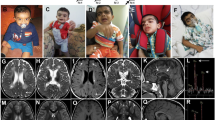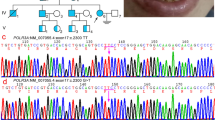Abstract
Hypomyelinating leukodystrophies are a group of neurodevelopmental disorders that affect proper formation of the myelin sheath in the central nervous system. They are characterized by developmental delay, hypotonia, spasticity, and variable intellectual disability. We used whole exome analysis to study the molecular basis of hypomyelinating leukodystrophy in two sibs from a consanguineous family. A homozygous mutation, c.3068+5G>A, was identified in the ATRN gene, with the consequent insertion of an intronic sequence into the patients’ cDNA and a predicted premature termination of the ATRN polypeptide. ATRN encodes Attractin, which was previously shown to play a critical role in central myelination. Several spontaneous ATRN rodent mutants exhibited impaired myelination which was attributed to oxidative stress and accelerated apoptosis. ATRN can now be added to the growing list of genes associated with hypomyelinating leukodystrophy. The disease seems to be confined to the CNS; however, given the young age of our patients, longer follow-up may be required.


Similar content being viewed by others
References
Charzewska A, Wierzba J, Iżycka-Świeszewska E, Bekiesińska-Figatowska M, Jurek M, Gintowt A, Kłosowska A, Bal J, Hoffman-Zacharska D (2016) Hypomyelinating leukodystrophies—a molecular insight into the white matter pathology. Clin Genet 90:293–304
Torii T, Miyamoto Y, Yamauchi J, Tanoue A (2014) Pelizaeus–Merzbacher disease: cellular pathogenesis and pharmacologic therapy. Pediatr Int 56:659–666
Sarret C, Lemaire JJ, Tonduti D, Sontheimer A, Coste J, Pereira B, Feschet F, Roche B, Boespflug-Tanguy O (2016) Time-course of myelination and atrophy on cerebral imaging in 35 patients with PLP1-related disorders. Dev Med Child Neurol 58:706–713
Kuramoto T, Kitada K, Inui T, Sasaki Y, Ito K, Hase T, Kawagachi S, Ogawa Y, Nakao K, Barsh GS, Nagao M, Ushijima T, Serikawa T (2001) Attractin/mahogany/zitter plays a critical role in myelination of the central nervous system. Proc Natl Acad Sci 98:559–564
Tang W, Gunn TM, McLaughlin DF, Barsh GS, Schlossman SF, Duke-Cohan JS (2000) Secreted and membrane attractin result from alternative splicing of the human ATRN gene. Proc Natl Acad Sci 97:6025–6030
Duke-Cohan JS, Gu J, DF ML, Xu Y, Freeman GJ, Schlossman SF (1998) Attractin (DPPT-L), a member of the CUB family of cell adhesion and guidance proteins, is secreted by activated human T lymphocytes and modulates immune cell interactions. Proc Natl Acad Sci 95:11336–11341
Schwartz MW (1999) Mahogany adds color to the evolving story of body weight regulation. Nat Med 5:374–375
Jéquier E (2002) Leptin signaling, adiposity, and energy balance. Ann N Y Acad Sci 967:379–388
Leibel RL, Chung WK, Chua SC Jr (1997) The molecular genetics of rodent single gene obesities. J Biol Chem 272:31937–31940
Spiegelman BM, Flier JS (2001) Obesity and the regulation of energy balance. Cell 104:531–543
Kuramoto T, Yamasaki K, Kondo A, Nakajima K, Yamada M, Serikawa T (1998) Production of WTC.ZI-zi rat congenic strain and its pathological and genetic analyses. Exp Anim 47:75–81
Kondo A, Nagara H, Akazawa K, Tateishi J, Serikawa T, Yamada J (1991) CNS pathology in the neurological mutant rats zitter, tremor and zitter-tremor double mutant (spontaneously epileptic rat, SER). Exaggeration of clinical and neuropathological phenotypes in SER. Brain 114:979–999
Kondo A, Sendoh S, Miyata K, Takamatsu J (1995) Spongy degeneration in the zitter rat: ultrastructural and immunohistochemical studies. J Neurocytol 24:533–544
Nunoya T, Tajima M, Mizutani M, Umezawa H (1985) A new mutant strain of Syrian hamster with myelin deficiency. Acta Neuropathol 65:305–312
Kuramoto T, Nomoto T, Fujiwara A, Mizutani M, Sugimura T, Ushijima T (2002) Insertional mutation of the Attractin gene in the black tremor hamster. Mamm Genome 13:36–40
Gunn TM, Inui T, Kitada K, Ito S, Wakamatsu K, He L, Bouley DM, Serikawa T, Barsh GS (2001) Molecular and phenotypic analysis of Attractin mutant mice. Genetics 158:1683–1695
Bronson RT, Donahue LR, Samples R, Kim JH, Naggert JK (2001) Mice with mutations in the mahogany gene Atrn have cerebral spongiform changes. J Neuropathol Exp Neurol 60:724–730
Gomi H, Ueno I, Yamanouchi K (1994) Antioxidant enzymes in the brain of zitter rats: abnormal metabolism of oxygen species and its relevance to pathogenic changes in the brain of zitter rats with genetic spongiform encephalopathy. Brain Res 653:66–72
T1 O, Ito H, Serikawa T, Sato K (1997) Detection of apoptosis in the brain of the zitter rat with genetic spongiform encephalopathy. Mol Biol Int 41:279–284
Muto Y, Sato K (2003) Pivotal role of attractin in cell survival under oxidative stress in the zitter rat brain with genetic spongiform encephalopathy. Brain Res Mol Brain Res 111:111–122
Duke-Cohan JS, Kim JH, Azouz A (2004) Attractin: cautionary tales for therapeutic intervention in molecules with pleiotropic functionality. J Environ Pathol Toxicol Oncol 23:1–11
He L, Lu XY, Jolly AF, Eldridge AG, Watson SJ, Jackson PK, Barsh GS, Gunn TM (2003) Spongiform degeneration in mahoganoid mutant mice. Science 299:710–712
Paz J, Yao H, Lim HS, Lu XY, Zhang W (2007) The neuroprotective role of attractin in neurodegeneration. Neurobiol Aging 28:1446–1456
Acknowledgments
This work was supported in part by the Trudy Mandel Louis Charitable Trust.
Author information
Authors and Affiliations
Corresponding author
Ethics declarations
The study was performed with the approval of the ethical committees of Hadassah Medical Center and the Israeli Ministry of Health. Parental consent was given for genetic studies.
Electronic supplementary material
ESM 1
(DOCX 17 kb)
Rights and permissions
About this article
Cite this article
Shahrour, M.A., Ashhab, M., Edvardson, S. et al. Hypomyelinating leukodystrophy associated with a deleterious mutation in the ATRN gene. Neurogenetics 18, 135–139 (2017). https://doi.org/10.1007/s10048-017-0515-7
Received:
Accepted:
Published:
Issue Date:
DOI: https://doi.org/10.1007/s10048-017-0515-7




